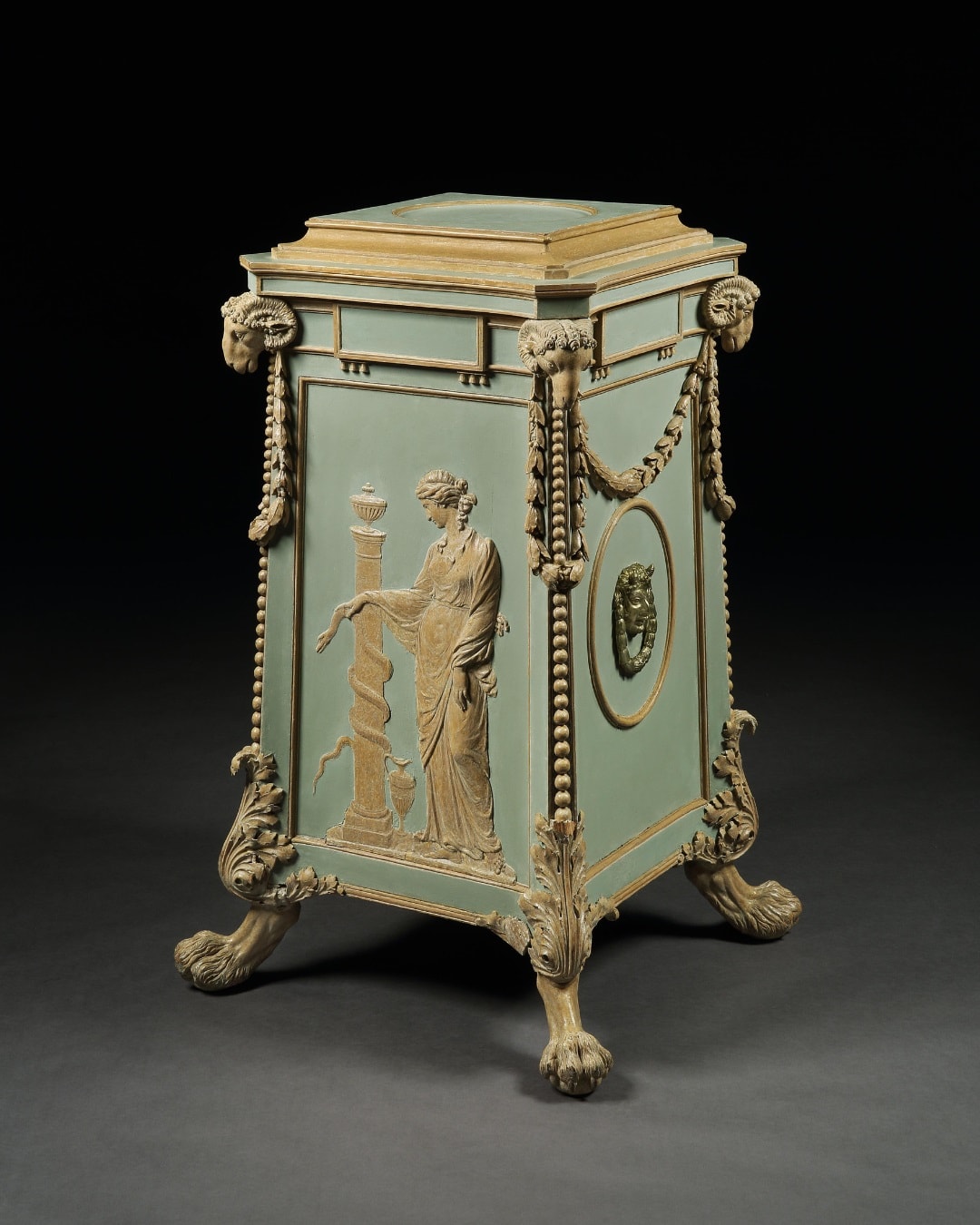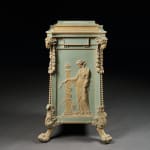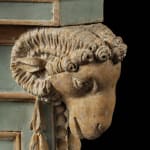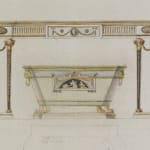
A coloured drawing by Robert Adam for the side table and wine cooler from the Etruscan dining room for Newby Hall, Yorkshire, 1783. Sir John Soane's Museum, London / Ardon Bar Hama
THE NEWBY HALL PLATE WARMER PEDESTAL, English, circa 1785
Width: 25 ¼ in; 64 cm
Depth: 25 ¼ in; 64 cm
Further images
A George III polychrome painted plate warmer pedestal almost certainly designed by Robert Adam, and almost certianly by Thomas Chippendale.
The pedestal retains the original chased brass handles and virtually all the original paint surface, with retouched areas. Both the pedestal and the brass handles had been painted many times over, preserving the original Adam colour scheme underneath. Paint analysis and careful dry stripping of the surface has revealed the original surface. The metal lined interior fitted out with racks is preserved in original condition.
THE NEWBY HALL COMMISSION (1772–1792)
William Weddell was born into a family of humble origins but great aspirations. His father Richard, the son of a York grocer, was born with the name Elcock. When Richard inherited a fortune from his uncle Thomas Weddell, who had invested in South Sea stock and made a huge profit, he took the name Weddell himself.
Richard Weddell bought Newby Hall in Yorkshire and property in London. He extended Newby with the help of the architect John Carr but died before the interior was finished, and it was left to William, who inherited Newby while on the Grand Tour in 1762, to complete the work.
Unlike many of his contemporaries on the Grand Tour who bought paintings, William returned with an important collection of marbles. These marbles were installed in a specially designed hall at Newby. Tapestries which he had ordered from the Gobelins factory in Paris were also installed, and seat furniture for the room was ordered.
Weddell employed Robert Adam to draw up the plans for Newby and its extensions. It is likely that Adam suggested commissioning Thomas Chippendale, who was already working a few miles away at Harewood House, for the furnishings.
The dining room at Newby was designed in the Etruscan manner, the most up-to-date style of the time. Robert Adam designed the sideboard and wine cooler for the room. The drawings for these, dated 1783, have been preserved in the Sir John Soane’s Museum in London. The final design for the plate warmer pedestal has not survived, but drawings for unexecuted variants (called by Adam ‘alternative designs’) have, suggesting that he provided the design for this pedestal as well, and that it was subsequently lost. The plate warmer pedestal is however described in detail in an inventory undertaken by Thomas Chippendale junior in 1792: ‘A Large Pedestal with Carv’d Goats heads & Lyons feet and a figure in front with swags of husks & c. Painted Grey, Black & Buff fitted up as a Plate Warmer.’
The similarities between the wine cooler and the pedestal are too compelling to dismiss. Both items feature a tablet motif with pendants below on each side. The wine cooler was over-painted in the 20th century, but areas where the paint is flaking off clearly show the same Etruscan colour combination as that described in the 1792 inventory. Paint analysis of the wine cooler may provide proof in the future that both it and the pedestal belong to the same suite.
The layout of the dining room allowed no space for a pedestal against a wall. The pedestal was therefore designed to be free standing, probably between central columns in front of the side table, with access from behind to open the doors. No other pedestal like this is known to exist.
To date this is only the second known commission for which Chippendale worked to Robert Adam’s designs, but the absence of documentation in the form of bills from Chippendale and the drawing for the pedestal means that we do not yet have absolute proof.
The Etruscan dining room at Newby Hall was short lived. Following William Weddell’s death in 1792, the property passed to Thomas Philip Robinson, Lord Grantham. The changes that he made to the house included turning the existing dining room into a library and creating a new dining room instead. The furniture for the new dining room was brought over from Newby Park, Lord Grantham’s ancestral home, and the Etruscan pedestal plate warmer became obsolete. Today, only the wine cooler and two painted side cabinets from the Etruscan suite survive at Newby Hall. All three have been repainted to complement the current décor of the house. The whereabouts of the serving table are not known.
The side cabinets from the Etruscan suite are constructed in pine rather than the expensive mahogany used for the pedestal, and they were originally fitted into a niche. This type of work was usually undertaken by joiners, who also made door frames and window frames, etc. The rest of the suite – the table, wine cooler and pedestal – was made by a cabinet-maker; in this instance, by Thomas Chippendale.
The pedestal is exceptionally well carved and constructed of mahogany. Its attribution to the Chippendale workshop rests on the ornate brass carrying handles fixed to the sides of the pedestal. These handles are identical to the handles used by Chippendale for the celebrated wine cooler at Harewood, supplied around 1771. The unique design of the handles is based on the mask of Bacchus, the god of wine. The same mask appears, carved in wood, on the side tables as well as the pedestal urns for the dining room at Harewood.
Close comparison between the handles of the pedestal and the Harewood wine cooler have revealed that they differ only in the chasing, and are without doubt from the same mould. Chippendale would have carved this handle in wood and had it cast in brass by a foundry. The chasing of each individual casting would have been done by the Chippendale firm, and the original wooden handle would have been retained by them for future use. This handle will be unique to the Chippendale firm. No other examples of its use have come to light.
Provenance
Commissioned by William Weddell for Newby Hall, Yorkshire, England;
Harry Rixson, Dunstable, Bedfordshire, England, where acquired on 26 May 1939 as a ‘Very Finely Carved Wood Adam Pedestal’ (£40);
Private collection, Bedfordshire.
Literature
Illustrated:
Ronald Phillips, The Legacy of Thomas Chippendale, London 2018, pp. 148-155.
Ronald Phillips, Fine Antique English Furniture, London 2019, pp. 276-280.







